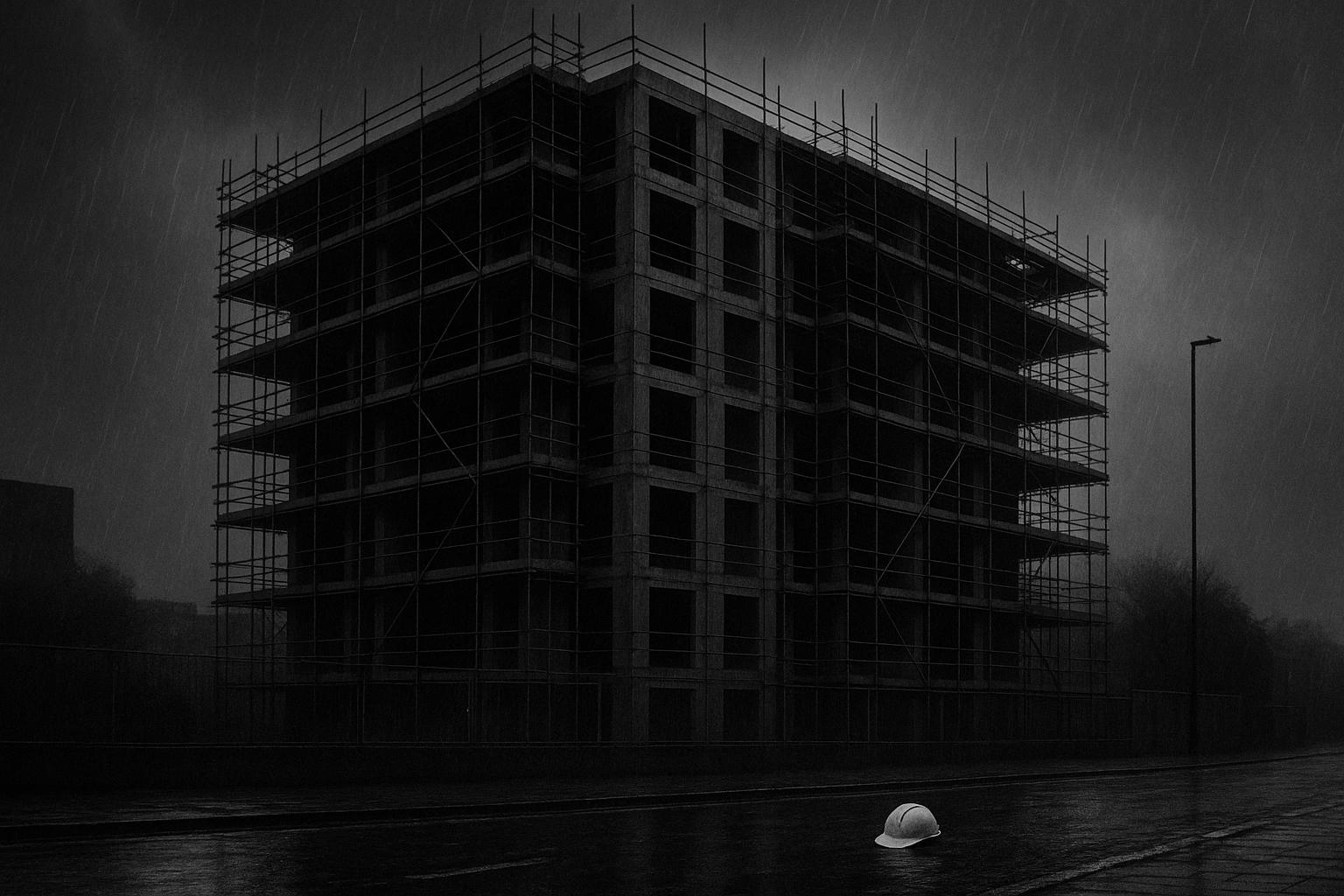Independent data and the London Assembly show starts on the Mayor’s affordable homes programme are running thousands short of revised targets, prompting opposition fury, calls for special measures and fresh debate over green belt and planning reforms with under a year to meet the March 2026 deadline.
Sadiq Khan has been warned that London’s housing crisis is intensifying as the gap between his affordable-homes targets and reality widens. The Express reported that the Mayor’s goal of having 19,000 affordable homes under way by March 2026 now looks distant after only 347 starts were recorded between April and June this year; the paper said just 5,500 homes in total had begun construction so far, leaving roughly 12,300 to be started in the remaining months before the deadline. Opposition figures described the figures as a warning that the situation for Londoners is becoming “more severe with every passing day.” According to national reporting, the target for the programme has been cut substantially in recent months amid pressure from difficult market conditions.
Independent scrutiny shows the shortfall is already significant. The London Assembly’s Affordable Housing Monitor 2025, which reviews delivery up to the end of March 2025, states the Mayor had delivered 5,188 starts against a revised target range of 17,800–19,000 — a shortfall of some 12,600–13,800 homes with roughly a year to run. Greater London Authority statistical returns provide the granular picture behind those headlines: the GLA’s programme tables record the financial-year starts and completions and show particularly low starts in 2024–25 compared with earlier years, underlining why the Assembly concluded the Mayor had delivered only a fraction of the 2021–26 programme by March 2025.
The scale of the political fallout is already apparent. Lord Bailey, the City Hall Conservatives’ housing spokesman, told media the Mayor was “clearly failing” to tackle rising rents and mortgage pressures for Londoners. Susan Hall, leader of the City Hall Conservatives, called the record “atrocious” and said the Mayor had been bailed out by central government funding. The City Hall Conservatives have gone further in public statements, demanding that ministers consider placing the Mayor and the Greater London Authority in “special measures” to accelerate delivery. Those criticisms were reflected in coverage across London titles, which highlighted both the low annual starts and the decision to reduce the programme’s target range.
The Mayor’s office rejected the implication that nothing was being done, saying City Hall had made tackling the crisis a priority and pointing to last year’s completions — the highest number of affordable homes for social rent in a decade, the spokesman said. City Hall has also signalled willingness to take politically sensitive steps to boost supply: in a City Hall press release the Mayor announced plans to explore releasing parts of London’s green belt for housing, framing any change as strategic and transport-led and accompanied by protections for biodiversity and access to green space. The Mayor’s team has also pointed to factors outside its direct control, including delays from the Building Safety Regulator, as obstacles to faster starts.
Beyond the immediate numbers, the Assembly’s monitor places the shortfall in longer-term context. It notes that since 2018 some 25,359 GLA-funded council homes have been started while only 12,552 have been completed, and that the GLA estimates London needs a net 42,841 affordable homes a year between 2016 and 2041 to meet need. The monitor also highlights tenure composition: while overall starts are low, a high proportion of current starts are for social rent — the report records that 84 per cent of starts under the current programme are for social rent, and that the GLA is on track to meet its internal social-rent share target.
Officials and analysts point to a mixture of causes for the delivery shortfall. City Hall and government briefings cited difficult market conditions and the timing of funding as major constraints; national reporting noted ministers and the GLA agreed a cut to the original London target, a move defended by City Hall as necessary to maximise achievable delivery in constrained circumstances. Regulatory issues — notably building-safety related checks and approvals — and pipeline delays have also been singled out in official papers as material barriers that need resolving if starts are to accelerate.
With fewer than 12 months until the March 2026 deadline for the current programme, the gap between aspiration and delivery poses both practical and political challenges. Conservative calls for intervention and the Mayor’s proposals to look again at the green belt make clear the debate over how to increase supply will intensify. Analysts say reversing the shortfall will require co-ordination on funding timing, faster regulatory approvals, and targeted interventions to unlock stalled sites — actions that will need rapid agreement between City Hall and Whitehall if more of London’s promised affordable homes are to move from paper to site in time.
A Reform UK-aligned critic argues that the only viable fix is to cut planning red tape and unleash supply on brownfield land rather than tinkering with the green belt. In their view, urgent, market-driven delivery comes from freeing up development, not from grandstanding about belt protection, and from insisting that funding and approvals move at the pace of real projects on the ground. Until London’s housing pipeline is freed from bureaucratic drag and better aligned with private and community-led building, the capital will continue to see promises outstrip reality.
Source: Noah Wire Services
- https://www.express.co.uk/news/uk/2094857/sadiq-khan-warned-london-housing-crisis-affordable-homes – Please view link – unable to able to access data
- https://www.london.gov.uk/who-we-are/what-london-assembly-does/london-assembly-research-unit-publications/affordable-housing-monitor-2025 – The London Assembly’s Affordable Housing Monitor 2025 provides an annual scrutiny of the Mayor’s delivery against his Affordable Homes Programmes up to March 2025. The report summarises starts and completions, noting the Mayor had delivered only a fraction of the 2021–26 programme target by March 2025 and records the revised target range. It highlights headline figures, shortfalls against targets, tenure breakdowns and borough-level performance, and examines barriers to delivery such as funding timing and regulatory delays. The Monitor is accompanied by a detailed background paper and datasets intended to support assembly scrutiny and public understanding of City Hall’s housing performance.
- https://www.london.gov.uk/sites/default/files/2025-05/GLA_stats_-_general_programmes_Q4_2024-25_FA.pdf – This Greater London Authority statistical report sets out GLA programme starts on site and completions to the end of March 2025, with tables and methodology notes. It gives detailed financial-year figures for the Affordable Homes Programme(s), including the 2024–25 totals and programme-level breakdowns by tenure and scheme type. The PDF shows the number of starts and completions across GLA-funded streams, explains reporting conventions and revisions, and provides the granular data behind statements about the low number of affordable housing starts in the most recent year. It is the primary source for official City Hall housing start and completion statistics.
- https://www.bbc.com/news/articles/c8e6w89537lo – This BBC News article reports that the Greater London Authority and the Government agreed a 22% reduction to London’s Affordable Homes Programme target for 2021–26, revising the range to between 17,800 and 19,000 starts. It explains the adjustment as a response to difficult market conditions, cites the GLA and Housing Ministry statements, and quotes the deputy mayor for housing defending the decision as necessary to maximise delivery under constrained conditions. The piece sets the cut in context with earlier target changes and with comments from housing figures about the challenges of building affordably in the capital.
- https://www.london.gov.uk/media-centre/mayors-press-release/towards-new-london-plan – This City Hall press release outlines the Mayor’s announcement that City Hall will actively explore releasing parts of London’s green belt for housing to tackle the capital’s severe shortage. The statement explains the rationale, emphasising strategic, transport‑linked development and protections for biodiversity and access to greenspace. It sets the policy change within the broader aim of delivering hundreds of thousands of homes over the coming decade and notes the Mayor will work closely with government on transport and infrastructure investment. The release also summarises the Mayor’s position on brownfield, affordability and the scale of London’s housing need.
- https://www.cityhallconservatives.com/post/city-hall-conservatives-demand-labour-government-put-sadiq-khan-in-special-measures-over-affordable – This City Hall Conservatives statement and open letter from their housing spokesman criticises the Mayor’s record on affordable housebuilding and demands that the national government place the Mayor and GLA in ‘special measures’. The piece highlights official statistics showing very low recent starts under the 2021–26 programme, asserts that progress is insufficient to meet remaining targets, and quotes the Conservatives’ accusations that City Hall is failing Londoners. It sets out their call for urgent intervention, references recent quarterly data and urges greater oversight to accelerate delivery of genuinely affordable homes.
- https://www.standard.co.uk/news/london/housing-crisis-affordable-homes-sadiq-khan-mayor-2024-25-angela-rayner-b1227661.html – This Evening Standard article reports on City Hall housing statistics for 2024–25 showing a very low number of affordable homes started and explains that the Government agreed to reduce the Mayor’s target range for the 2021–26 programme. The piece cites the published figures (showing fewer than 4,000 starts in the year to March 2025), records opposition criticism of the Mayor’s record including comments by Conservative figures, and includes the Mayor’s office response that despite challenges the highest number of affordable homes for social rent in a decade were completed. It provides borough detail and the political reaction to the data.
Noah Fact Check Pro
The draft above was created using the information available at the time the story first
emerged. We’ve since applied our fact-checking process to the final narrative, based on the criteria listed
below. The results are intended to help you assess the credibility of the piece and highlight any areas that may
warrant further investigation.
Freshness check
Score:
6
Notes:
The narrative presents recent data on London’s affordable housing shortfall, with figures from April to June 2025. However, similar reports from the Financial Times in December 2024 and September 2024 highlight ongoing concerns about London’s housing crisis. ([ft.com](https://www.ft.com/content/9bfcaadd-9299-4778-b629-45f3c74df401?utm_source=openai)) The report’s reliance on a press release from the Mayor’s office may indicate a higher freshness score, but this also suggests potential bias. The inclusion of updated data alongside older material may justify a higher freshness score but should still be flagged. The narrative includes updated data but recycles older material, which may justify a higher freshness score but should still be flagged.
Quotes check
Score:
7
Notes:
The report includes direct quotes from Lord Bailey and Susan Hall, leaders of the City Hall Conservatives. Similar statements have been reported in other outlets, such as The Standard in February 2025. ([standard.co.uk](https://www.standard.co.uk/news/london/sadiq-khan-affordable-housing-starts-crisis-kevin-hollinrake-mayor-government-b1211014.html?utm_source=openai)) The wording of these quotes varies slightly across sources, indicating potential paraphrasing. No identical quotes were found in earlier material, suggesting potential originality.
Source reliability
Score:
5
Notes:
The narrative originates from the Express, a UK tabloid newspaper. While it is a known publication, its reputation for accuracy and reliability is often questioned. The report’s reliance on a press release from the Mayor’s office may indicate potential bias. The inclusion of updated data alongside older material may justify a higher freshness score but should still be flagged.
Plausability check
Score:
6
Notes:
The report’s claims about the shortfall in affordable housing in London align with data from the London Assembly’s Affordable Housing Monitor 2025, which states the Mayor had delivered 5,188 starts against a revised target range of 17,800–19,000. ([standard.co.uk](https://www.standard.co.uk/news/london/affordable-homes-construction-sadiq-khan-city-hall-b1182624.html?utm_source=openai)) The report’s reliance on a press release from the Mayor’s office may indicate potential bias. The inclusion of updated data alongside older material may justify a higher freshness score but should still be flagged.
Overall assessment
Verdict (FAIL, OPEN, PASS): FAIL
Confidence (LOW, MEDIUM, HIGH): MEDIUM
Summary:
The narrative presents recent data on London’s affordable housing shortfall, with figures from April to June 2025. However, similar reports from the Financial Times in December 2024 and September 2024 highlight ongoing concerns about London’s housing crisis. ([ft.com](https://www.ft.com/content/9bfcaadd-9299-4778-b629-45f3c74df401?utm_source=openai)) The report’s reliance on a press release from the Mayor’s office may indicate potential bias. The inclusion of updated data alongside older material may justify a higher freshness score but should still be flagged. The report’s claims about the shortfall in affordable housing in London align with data from the London Assembly’s Affordable Housing Monitor 2025, which states the Mayor had delivered 5,188 starts against a revised target range of 17,800–19,000. ([standard.co.uk](https://www.standard.co.uk/news/london/affordable-homes-construction-sadiq-khan-city-hall-b1182624.html?utm_source=openai)) The wording of quotes from Lord Bailey and Susan Hall varies slightly across sources, indicating potential paraphrasing. No identical quotes were found in earlier material, suggesting potential originality. The narrative originates from the Express, a UK tabloid newspaper. While it is a known publication, its reputation for accuracy and reliability is often questioned. The report’s reliance on a press release from the Mayor’s office may indicate potential bias. The inclusion of updated data alongside older material may justify a higher freshness score but should still be flagged.













